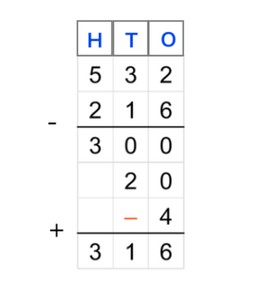
Partial differences subtraction to 1,000 with regrouping
Students learn partial differences subtraction to 1,000 with regrouping.



8,000 schools use Gynzy
92,000 teachers use Gynzy
1,600,000 students use Gynzy
General
Students learn partial differences subtraction to 1,000 with regrouping.
Standards
-2.NBT.B.7 / 3.NBT.A.2
Learning objective
Students will be able to subtract using the partial differences method to 1,000 with regrouping of the tens and hundreds numbers.
Introduction
You should different images on the interactive whiteboard. The images form amounts. Ask the students which amounts belong with which TO-table. Ask how they know this. Then you show a number of eggs for which the correct amount must be dragged to each side.
Instruction
Explain that for partial differences subtraction you put the numbers one under the other. Then you can subtract them from one another by working from left to right. So you start with calculating the hundreds numbers. You subtract them from each other. Then you subtract the tens numbers and finally the ones numbers. With subtracting the ones values it can happen that you come up short. In that case you write a minus sign. You put all these answers in the diagram and write the intermediate differences are. You then add all of the answers together, besides the ones value if you were short. You subtract that number. Then you will arrive at your final answer. You put this final answer at the bottom of the diagram. Next, there is a problem in a diagram for which different rows are marked in yellow. Ask the students if they know which intermediate difference belongs in each colored row. This is how you can check whether students know which steps they must take. After this, have the students solve a few problems using partial differences. Then you explain that you can also come up short in the tens numbers. In that case, you also write a minus sign. Then practice partial differences further with two problems, for which one the diagram is already filled in and the other must still be filled in.
Check whether the students can subtract using partial differences with the following questions/exercise:
- Why is it useful to be able to subtract using partial differences?
- What do the letters H T O mean?
- Where do you always start when you calculate partial differences?
- Solve these using partial differences: 856 - 92 and 936 - 473
Quiz
The students are given ten questions in which they practice partial differences subtraction. They are given questions in which they must determine the intermediate difference and also solve entire problems.
Closing
You discuss again with the students how it is important to be able to subtract with partial differences to 1,000 because that is how you can solve problems in steps. Check if the students know that in partial differences they must work from left to right and if you come up short in a number they must add a minus sign. Have the students come up with some problems on their own by dragging numbers into the HTO-diagram. Make sure that for some of these problems there is a shortage in the ones values, tens values, or both.
Teaching tips
For students that have difficulty with subtracting using partial differences, you can repeat the meaning of H T O and remind them of how you put numbers into an HTO-diagram. Write down the intermediate steps. You may mark the hundreds numbers, tens numbers and ones values, so that it is obvious what they are subtracting.
The online teaching platform for interactive whiteboards and displays in schools
Save time building lessons
Manage the classroom more efficiently
Increase student engagement
Discover more!
About Gynzy
Gynzy is an online teaching platform for interactive whiteboards and displays in schools.
With a focus on elementary education, Gynzy’s Whiteboard, digital tools, and activities make it easy for teachers to save time building lessons, increase student engagement, and make classroom management more efficient.



